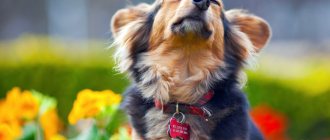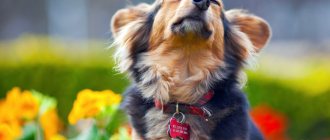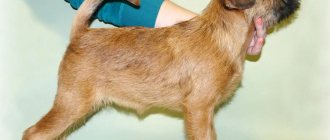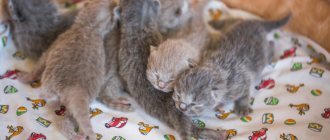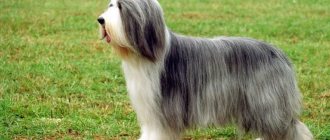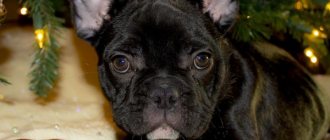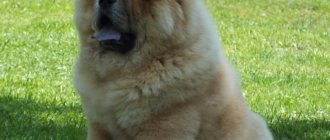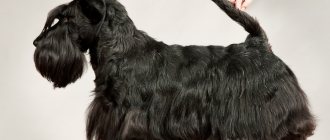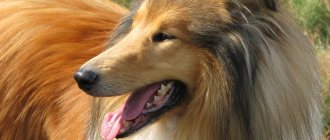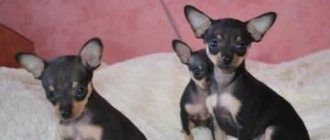4.6/5 — (5 votes)
Shih Tzu dogs are great for apartment living. One of the distinctive features of this breed is the absence of a specific “dog” smell. Another feature is their coat. It is very thick and long. This gives free rein to imagination and allows owners to create different hairstyles for their pet using hair accessories - elastic bands, barrettes, clips and ribbons.
Features of a lion cub dog: brief characteristics and description of the breed
Shih Tzu is a decorative breed, considered one of the oldest. Their height does not exceed 27 cm at the withers, and their weight is 8 kg.
The breed is called a chrysanthemum dog because the fur on its face resembles the flower of the same name. The pets were also nicknamed “lion cub” (translation of the word “Shih Tzu” from Chinese) and “Buddha’s dog.” Allegedly, the dogs accompanied him during his travels.
Shih Tzus have long, luxurious fur. On the muzzle it forms a “beard” and “mustache”. Folded proportionally. The dogs are lean, muscular, with well-developed bones.
Having a chrysanthemum dog is almost the same as bringing a ray of sunshine into your home. Some owners believe that their pets understand human speech. This is how they detect the slightest changes in people’s moods.
Dogs love to be the center of attention. At the same time, they are unobtrusive. If there is no time for them now, they will simply sit nearby and wait for the owner to sort things out.
Shih Tzus are gentle, affectionate and loving creatures. In puppyhood they are extremely active, curious, and playful. After a year they become more seasoned, but remain lively until old age.
We recommend reading: Pocket dogs: review of breeds, tips for choosing
History of the breed
These dogs appeared in Europe just under 100 years ago and quickly gained popularity. They became especially in demand in Great Britain, where many representatives of the breed settled in the homes of aristocrats and wealthy people.
This choice is easy to explain: Shih Tzus are very attractive and even touching in appearance. They have beautiful fur, and their face, when properly groomed, resembles that of a bear cub. It has become fashionable not only to keep babies in the house, but also to take them with you, since the compact size and sociable nature of the pet allow this.
In 2004, American scientists decided to check the pedigree of the breed and found out amazing things. Firstly, the Shih Tzu dog is one of the oldest on the planet and has remained virtually unchanged in appearance over the millennia of its existence. Secondly, she has Asian roots: the ancestors of these kids lived in Tibet, and in the middle of the 17th century, the Dalai Lama gave a pair of miniature dogs to the Emperor of China.
Since then, Shih Tzu puppies have become worth more than just their weight in gold. Dogs lived only at the emperor’s court, and none of the “mere mortals” had the right to keep a favorite of this breed. Only from time to time the emperor, who wanted to demonstrate his special affection to his immediate circle, could present a puppy of this breed as a gift. The gift was considered priceless, and the person who dared to steal the dog from the owner faced the death penalty.
Fact. According to one version, the name of the breed is translated as “lion dog.” There is a legend that it was the Shih Tzu that accompanied the Buddha on his travels, and in case of danger it turned into a lion to protect its owner. According to another version, the name means “beautiful dog,” which is associated with the name of Empress Xi Shi, whom the Chinese honor as one of the greatest beauties of the ancient world.
pixabay.com/Anyall
How to care for a baby Shih Tzu: basic rules and recommendations
All about hair care
Long, thick, luxurious hair is the main advantage of a dog. This is where the most problems arise, since caring for a Shih Tzu's coat is quite complicated.
Bathing
Your Shih Tzu should be bathed every week and a half. Clean wool is less tangled.
The pet must be placed in a bathtub or a wide basin. Place a rubber mat on the bottom to prevent the paws from slipping. The water temperature should be 37-38°C.
Bathe your pet with a special shampoo for long-haired breeds. Thoroughly wash the paws, stomach, back, and genital area. The foam is washed off several times. For easy combing, it is recommended to use conditioner.
Before bathing and after drying, the dog is combed to prevent tangling of the hair. To keep the dog from freezing and drying faster, wrap it in 2 bath towels and use a hairdryer.
Combing
Your Shih Tzu needs to be brushed daily, for an average of half an hour. Otherwise, tangles will form.
Puppies begin to be accustomed to the procedure at 6 weeks of age. Use special brushes: a wide-toothed comb and a massage brush.
If you get completely tired of combing, you can cut the dog “puppy style.” This haircut is especially important in the fall and spring, when the Shih Tzu literally collects all the dirt in its path. However, this way the dog loses some of its charm.
Before the procedure, the dog is placed on the table. It is advisable to place a rubber mat for stability.
They start scratching from the hind legs. First - with a comb, and then with a massage comb. On the back, the fur is divided into two parts.
You should not comb a pet with dry hair. Be sure to use a spray conditioner or moisten the comb with a spray bottle. Tangles that cannot be combed out are carefully removed with a tangle cutter.
Hygienic haircut
Dogs should be trimmed as their fur grows back. To maintain hygiene and a neat appearance, it is advisable to trim your hair at least once a month. But at least once every 3 months, otherwise the dog will become very overgrown.
To get a monthly hygienic haircut, you don’t have to take your dog to the groomers.
The procedure itself is simple, accessible to any owner at home. As a rule, the paws, groin area, and base of the tail are trimmed - there are no difficulties with this. Before grooming, your pet must be bathed and combed.
Dogs participating in exhibitions are not cut. The Shih Tzu standard requires a long and thick coat. But in such cases, the coat requires special care, regular trimming and combing.
Exhibition “specimens” are usually trusted only by professional groomers.
We recommend reading: Hair loss in dogs - causes, prevention, treatment
Taking care of your eyes: removing hair and nitrous oxides
The Shih Tzu's eyes tend to become sour. To prevent wool from getting into them, it is collected on the top of the head in a ponytail. This will provide ventilation.
Tear ducts are checked daily. Oxide is removed with a sponge dipped in lotion or distilled water.
Ear care: clean and remove excess hair
Large hairs from the ears are plucked out with tweezers. Inspect the ears daily for dirt and parasites. However, cleaning once a week with a cotton swab is sufficient.
Shih Tzu teeth: properly clean and remove plaque
Teeth should be cleaned of plaque once a week with a special toothbrush and toothpaste for dogs.
If a stone appears, you need to contact a veterinarian. The doctor will remove hard deposits. You cannot do this yourself - you can damage the enamel.
How to care for paws and trim claws
The paws are inspected and dirt is cleaned between the toes after each walk. Excess hair is cut off.
The claws are trimmed with a nail clipper as they grow. It is better to do this after swimming, when the nail plate is soft. Only the upper third is cut - then there is the “living part” with nerves and blood vessels.
Features of walking puppies and adult dogs
They start walking the puppy at 3.5 – 4 months. The first walks last no more than 15 minutes.
Babies can be taken outside up to 5 times a day. Gradually, the number of walks is reduced and their duration is increased.
Adult pets do not need long, intense walks. It will be enough to take the dog out once a day for an hour.
The Shih Tzu's flattened face makes it difficult to breathe. Therefore, the dog should not be walked in the sun.
And for the autumn-winter period you will need warm clothes.
Upon arrival home, the paws, ears, eyes, skin and fur are carefully examined. It is necessary to clean out the trapped dirt, make sure that the organs are not injured and there are no mites.
Antiparasitic treatment must be carried out every 3 months and 2 weeks before vaccination.
Caring for your dog's paws and claws
The owner of a Shih Tzu should get into the habit of constantly caring for the dog's paws by inspecting the pads of his pet's paws, making sure that tangles do not form between the toes, and also trimming the hair around the paws. The fact is that plant thorns or glass fragments can get stuck in the paw pads, and plasticine or chewing gum can stick. All this causes the dog inconvenience and discomfort.
For example, I have an eternal problem - this is burrs. If you don’t pull them out right away, then this procedure becomes much more difficult, because the burdock becomes even more entangled in the fur. However, I can’t forget about them - my dog becomes restless and refuses to go.
I constantly trim the hair between the toes of my Shih Tzu to prevent tangles from forming, because combing it in these places is quite difficult, almost impossible. In summer, it is necessary to ensure that the dog does not run through fuel oil or heated tar. Otherwise, it is necessary to treat the paw pads with animal or vegetable fat, and then rinse them with a liquid to wash off these substances.
In winter, it is necessary to wash your pet’s paws with water and then treat them with a rich nourishing cream. This is done in order to avoid exposure of the skin of the paws to the reagents that are sprinkled on roads. If cracks do appear on the pads, it is necessary to lubricate the damaged skin with propolis tincture.
A dog's nails also need care. If the dog runs quite often on rocky surfaces or asphalt, then the claws wear down on their own. Otherwise, the owner of the Shih Tzu must trim them. I perform this procedure once a week, immediately after bathing the dog, when the claws are steamed and more pliable.
The owner should keep in mind that the claw contains a blood vessel that can be damaged. To prevent this from happening, the claw is held up to the light, thereby determining the area of the living zone. Trimming is done below the pink area. If you constantly do this in the same place, then the living part will move a little over time.
If a dog's nails are not trimmed, they can become bulging, peeling, and breaking.
This will cause pain and discomfort to the dog and lead to inflammation of the periungual fold, which is extremely undesirable. At the same time, the Shih Tzu may begin to limp and fall on a sore paw. Particular attention should be paid to the claw, which does not touch the road and never gets worn down. Such a claw can even dig into the skin of a dog's paw.
In the event that the living part of the claw is still touched during trimming and blood begins to flow, it is necessary to treat the wound with ferrous sulfate powder. The powder stays on the wound for several minutes, after which it is not recommended to wet the wound with water for some time.
If your dog is patient in caring for the dog's paws, then after trimming the nails, they can be treated with a nail file. We hope that our article on caring for your pixie helped you understand many points that were not entirely clear to you before. Useful tips that will not only make your life easier, but also the maintenance of your pet in general.
An unpretentious companion: keeping a pet at home
Shih Tzus are unpretentious in their maintenance. They easily adapt to life in a country house and a noisy metropolis. They get along perfectly in multi-storey buildings - even a one-room studio apartment will seem like a luxury apartment to the dog.
The chrysanthemum dog is primarily a companion. She must constantly be with people. Putting her in an enclosure is a crime.
The place is arranged in a cozy place, but in such a way that the pet can monitor everything that is happening in the house. It should not be in a draft, near heating appliances or air conditioners.
Decorative dogs can be trained to go to the toilet on a cat tray or a special diaper.
We recommend reading: TOP 10 dog breeds for apartment living
Training
The Shih Tzu is an intelligent and quick-witted breed, but is reluctant to train. Therefore, it is best to teach her not tricks, but important commands. These include: “No”, “Place”, “Walk”. It is important from childhood to accustom the puppy to home examinations and to the doctor.
The puppy needs to be taught commands. Adult pets do not like to study. It is better to walk with the puppy on busy streets so that he gets used to the noise, rides on public transport, and learns to communicate with other dogs on the site.
To summarize, we can highlight the main pros and cons of the breed:
- A compact and clean dog is ideal for an apartment.
- Quickly gets accustomed to the tray.
- No dog smell.
- Does not require physical activity, just walks and indoor games.
- A cheerful dog, a good friend for one owner or the whole family.
- Not suitable for an active lifestyle.
To prevent hereditary and acquired diseases from darkening the dog’s life, you need to visit the veterinarian on time and monitor the cleanliness of the animal. It is difficult to determine the health status of a small puppy, except for its general appearance, so it is better to buy it from good breeders.
Nutrition is the basis of a pet’s health and activity
An important aspect of proper care is proper feeding. Natural nutrition is considered ideal.
A natural food diet should include:
- raw meat and offal;
- vegetables and fruits;
- dairy products;
- additional ingredients - eggs, nuts, vegetable oils.
You can choose high-quality premium food. The most popular among owners are Royal Canin, Acana, Origine, Eukubana. Choose products from a special line for small breeds and taking into account the age of the pet.
The dog should not be overfed. She is prone to obesity. On a natural basis, vitamin-mineral complexes will not be superfluous.
We recommend reading: How to properly feed your dog natural food?
The best conditions for a dog
Before placing your chosen pet in your house or apartment, try to create the most comfortable conditions for its maintenance so that it is easier and faster for it to get used to the new place. To do this, you should choose the most comfortable corner of the room with good lighting , where you need to place a special house or a comfortable wicker basket.
The place must be located away from any heat sources and drafts. For this purpose, it is strictly not recommended to choose: a bathroom, a kitchen and a corridor.
A few words about education
Raising a Shih Tzu is a pleasure. They are obedient and quickly understand what is wanted from them. Although this is not a working breed, the dogs easily remember basic commands. With due diligence, they can perform small tricks: bring slippers, newspapers, ask, overcome obstacles.
Additionally, you can do agility or freestyle.
Chrysanthemum dogs are sensitive. Harsh upbringing is not acceptable. A reprimand in a menacing voice will be sufficient as punishment.
Tips for choosing a puppy
Recently, Shih Tzu puppies have become very popular. The market meets the requirements and more and more babies are appearing on sale, which is strange, because there are not many official nurseries. A similar situation occurs with Japanese Chins and other rare breeds. Businessmen make money from naive connoisseurs of small breeds by selling dogs of unknown origin under the guise of purebreds.
Decide in advance about your intentions: do you need a friend or a promising show dog? Paying an inflated price, choosing a puppy that is promising for breeding and not breeding it is not reasonable and disrespectful towards the breeder. When choosing a friend, you must make sure of the health of the parents, the physical strength of the puppy, and color and other exterior features are not so important.
Remember! For whatever purpose you decide to get a Shih Tzu, you need to take into account their affection and dependence on the person. A dog deprived of attention becomes very sad and may fall on its paws in pain or even die.
Be that as it may, we recommend choosing a Shih Tzu puppy from officially registered breeders. You may be able to purchase a pet-class puppy or one with minor defects, but you will be sure that:
- The Shih Tzu will correspond to the description and characteristics of the breed.
- You will not find unexpected ailments inherited by the puppy.
- You can contact the breeder for advice on the care, feeding, maintenance or treatment of your pet.
- The dog will be purchased under a contract, which makes it possible to assert your rights and contact kennel clubs in case of obvious deception.
- The parents of the puppies were selected based on physical health and mental stability.
Note! The parents' documents must be listed in a large kennel club. Fraudsters create private organizations and sell mongrel dogs with fake documents.
Taking care of your health: how to avoid diseases and prolong your life
The Shih Tzu is a strong breed. Some representatives lived up to 20 years. With proper care, the pet will delight its owners for 15–16 years.
Vaccination
The owner of the nursery must be asked for documents confirming vaccination. If the puppy has not yet had vaccinations, they are given according to the scheme:
- 1st course – at 8 – 9 weeks;
- 2nd course – at 10 – 12 weeks;
- subsequently – annually.
Shih Tzus are vaccinated against:
- plague;
- rabies;
- parovirus enteritis;
- parainfluenza;
- leptospirosis;
- Lyme disease.
After vaccination they are quarantined for 2 - 3 weeks. During this period, walks and contact with other animals, especially stray ones, are prohibited.
Possible diseases and their prevention
Shih Tzus are prone to certain diseases:
- Eye pathologies.
The most common cases are distichiasis, entropion, cataracts, and corneal ulceration. The first two diseases cannot be prevented. To avoid the rest, you need to wash your eyes daily, remove oxides and dirt, and include foods containing vitamin A or vitamin complexes in your diet.- Urolithiasis
. Most often found in males. It develops against a background of low mobility, excess protein and lack of water in the diet.- Disorders of the digestive system.
For prevention, you should not overfeed your Shih Tzu, give fatty meat, or unhealthy treats: sweets, baked goods, bones.- Allergies.
If itching, rash, or hair loss occurs, it is necessary to identify the allergen. As a rule, this is something from food or grooming products. The provoking factor must be eliminated.- Heart disease and tracheal collapse.
Genetically determined diseases. Before buying a puppy, you need to make sure that its parents do not have such pathologies. However, this will only reduce the likelihood of getting a sick puppy, but will not reduce the risk to zero.- Diseases of intervertebral discs
. To avoid problems with bones and joints, the dog is prohibited from climbing onto high surfaces and jumping off beds, sofas, and tables.
Until 3 months of age, care must be taken to ensure that the puppy does not go up or down stairs. This can cause the hind legs to become bent.
Choosing a puppy (price)
It is not difficult to choose your best friend among the Shih Tzu puppies, but when visiting several nurseries for this purpose, you should be sure to initially observe the kids and their parents. that is healthy in all respects is determined by the following criteria:
- curiosity (trying to sniff, wagging tail);
- not aggressive or timid;
- eyes are clean, without any discharge;
- the eyelids are not turned out;
- the coat is shiny and without bald spots;
- there are no manifestations of any diseases on the skin (scratching, rash, redness);
- the ears are clean and have no foreign odor;
- the stomach is not bloated;
- good appetite and moderate thirst.
Many dog breeders sometimes advise not to choose the oldest puppy from the litter or the youngest, explaining this by the fact that the older ones have a too domineering and stubborn character, and the latter differ from other babies in their weakness. But true animal lovers, as a rule, choose four-toed friends for themselves based on personal sympathies, without paying attention to outside assumptions.
Important! Shih Tzu dogs are sold at a fairly high price, which directly depends on their category. For example: an economy class baby will cost you from 20 to 200 dollars, a Standard class puppy - from 300 dollars, and a luxury class puppy, which, in addition to all veterinary passports and pedigree, has high prospects in a show career and in breeding - from 1100 up to $3400.
Positive and negative aspects of the breed
Cutie Shih Tzus have many advantages, but they also have disadvantages.
The advantages of the breed include:
- mental stability;
- good character - dogs get along well with all family members, love children and easily find a common language with other pets;
- lack of anger, aggression;
- good health;
- there is no need to walk your pet for a long time and often;
- hardly bark;
- ease of education and training.
The Buddha dog has much fewer disadvantages:
- long-term daily grooming is required;
- lack of guard qualities;
- does not tolerate loneliness well, even if the owner is in the next room.
Some representatives may be capricious, disobey commands, and overreact even to mild remarks. Usually this behavior appears due to improper upbringing - lack of attention or excessive spoiling.
We maintain cleanliness
Long silky hair in problem areas must be kept clean, for which special techniques are used:
• Tie a nice ponytail on top of your dog's head so as not to interfere with his vision, but use an elastic, soft elastic band. • When eating, Shih Tzus get the fur around their mouth dirty, so it needs to be tied up or washed thoroughly after eating. • The dog's eyes often water, so these areas need to be wiped daily so that the Shih Tzu, whose care and maintenance require special care, remains a healthy and cheerful pet.
If you decide to cut your dog’s hair, it is best to do this after 10 months, when the hair becomes long enough, and contact only professionals.
Brief summary
Shih Tzus are easy to keep, raise and train. But they are difficult to care for. The main troubles are associated with thick long hair. Dogs shed quite intensively, especially in spring and autumn.
We recommend reading: Pomchi - a cross between a Chihuahua and a Pomeranian
Appearance
A luxuriously groomed dog with a funny face. The breed description specifies that Shih Tzus should not be fur-bearing and should not resemble Apso. To a beginner, these two breeds may seem similar, but they have different origins, and the differences in appearance are obvious.
The breed characteristics describe the Shih Tzu as a cheerful and friendly companion. Four-legged animals are always cheerful and active, and are arrogant and proud with strangers. When evaluating dogs at breed shows, the physique, breed traits, color and, last but not least, the size of the Shih Tzu are assessed.
The established standards are quite vague, which gives breeders an additional opportunity not to sacrifice the exterior for the sake of size:
- Height up to 27 cm.
- The weight of an adult dog ranges from 4.5–8.1 kg.
Note! Weight up to 7.5 kg is preferred (over 15 months of age).
Breed standard
- The head is voluminous, quite large, but not too heavy. In males and females, the size and roughness of head carriage differ; when comparing two dogs of different sexes, this feature should be taken into account. The forehead line is not too wide, with smooth, rounded edges. The cheekbones and chewing muscles are developed, but should not stand out in the silhouette of the muzzle (the muscles are flat). The transition from forehead to muzzle is pronounced and sharp. Pinned bangs should emphasize the transition, but not aggravate it. When viewed from the front, the top of the nose should be in line with the lower eyelids. The front part is rectangular, without folds.
- The teeth are small, densely and evenly set. The bite is straight or moderately overshot.
- The nose is of proportional size and has wide nostrils (narrowed nostrils are a disadvantage). The bridge of the nose is free from folds, and the dog's breathing is deep and even even in a stressful situation. Dogs have a brown or brown-spotted color and a dark brown (liver) nose. Shih Tzus are gray and blue in color; the nose can be deep gray, although such pigmentation is not recommended. For other colors, only a black nose is acceptable. Pink spots or clearly lightened pigmentation are a fault.
- The eyes are expressive, round in shape, not protruding. The color of the irises is dark brown, although light pigmentation is acceptable in brown, gray and blue dogs. The eyelids are tight-fitting, colored to match the nose.
- The ears are large, set below the top of the head, but above the eyes, decorated with abundant and long hair. The outdated standard allowed low set ears (at the level of the corners of the eyes).
- The body is elongated, that is, the height at the withers is less than the length of the back from the withers to the base of the tail. The neck is of medium length with an expressive arch. The withers are moderately pronounced, the back is straight (not sagging), the chest is proportionally wide, falling slightly below the elbows.
- The limbs are strong, moderately wide, rounded in cross-section. The shoulders are inclined towards the body, the forearms and pasterns are as vertical as possible. Hind legs with balanced angulations, thighs well rounded and muscular. The hands are well selected, abundantly covered, the fingers are compressed, the pads are convex and strong, the claws are arched.
- The tail is of natural length, carried over the back. Due to the set and abundant hair, the tip of the tail is in line with the crown, which gives the dog a more balanced appearance.
Character
The Shih Tzu's character may seem proud and selfish. In fact, representatives of the breed have an instinctive need for human attention. Before you adopt a puppy, you should evaluate your ability to spend enough time with it.
Considering the history of the origin of the breed, self-love in these small dogs, as well as self-esteem, does not go away. For thousands of years, their ancestors lived in the palaces of emperors. When they began to spread throughout Europe, the attitude towards them remained the same, they were treated like elite class dogs. All this left a positive imprint on the character of the animals. They are self-possessed, do not bark over trifles, and are clean.
Innate cleanliness requires special care for your pet at home: it does not tolerate dirt and dust. Shih Tzus are more suitable for living in an apartment than in a private home.
In general, the character of the Shih Tzu is positive. Being surrounded by the owner and his family, the pet will be gentle and affectionate. He will get along well with family members of all ages: he will become an excellent companion for the elderly, will brighten up their loneliness, and will gladly support children in their fun and games.
The main character trait of the Shih Tzu is devotion; the dog’s lifelong desire is to be with its owner at all times. Owners are required to be aware of the animal's attachment. Long separation can cause loss of appetite, deterioration of health, and mental illness may develop.
Health, tendency to disease
Shih Tzu can rarely be found in veterinary hospitals, since representatives of the breed are distinguished by good health and strong immunity. However, exterior features can become a predisposing factor for diseases of the eyes, ears, teeth, and spine. Common ailments:
- cataract (clouding of the lens);
- distichiasis (extra eyelashes);
- ear infections;
- pathologies of the oral cavity (periodontitis, periodontal disease);
- curvature of the spine;
- heart diseases;
- urolithiasis disease;
- dandruff, baldness.
Genetic diseases are quite rare, they include:
- nephropathy (damage to the kidney parenchyma, glomerular apparatus);
- heart disease;
- congenital dislocation of the knee joint.
Feeding
What food is best to feed your Shih Tzu? It depends on the choice of the owner. You can give both dry food and natural food. You cannot mix feeding types. Advantages of dry food: balance, ease of preparation, varied diets (including therapeutic diets).
Dry food
Feeding rules:
- It is strongly not recommended to use economy class food.
- A bowl of fresh water should always be available.
- Buy food taking into account age and constitutional restrictions (the packaging is marked “for puppies”, “for adult dogs”, etc.).
- Calculate the daily volume individually, reducing or increasing the serving size (depending on whether the dog is gaining weight or losing weight).
- You should not switch to a new brand of food immediately, but within 5-7 days. This will allow your dog to avoid stomach problems.
- Vitamin and mineral supplements cannot be given additionally.
Treats are not excluded with this type of feeding. Recommended: cheese (finely chopped), dried fruits, dried apricots, croutons, boiled meat in pieces (except pork). You can buy special treats for dogs, vein bones.
Natural nutrition
The diet should include raw meat and offal (at least 20% of the daily amount of food). The daily norm is for a puppy 5-10% of weight, for an adult – 3-5%. Feeding frequency (any type of feed):
- 1.5-3 months. — 5-6 rubles/day;
- 3-6 months — 4 rubles/day;
- 6 months – 1 year – 3 rubles/day;
- from 1 year - 2 rubles/day.
Try to keep the loss of vitamins to a minimum during heat treatment of foods. Food should be as digestible as possible. After feeding, the bowl should be washed and put away. If the dog doesn't like the food and doesn't eat it, put the bowl in the refrigerator. Next time, reheat the food and give it to your pet again. If all the food is eaten, and the dog is clearly not full, increase the serving size.
What to feed a Shih Tzu puppy (sample menu):
Age up to 3 months. (6 rubles/day):
- 1st feeding: porridge with milk with the addition of ¼ boiled yolk;
- 2nd feeding: grated carrots with vegetable oil;
- 3rd feeding: cottage cheese (add milk/kefir);
- 4th feeding: sea fish without bones or meat (boil, give with broth);
- 5th feeding: stewed vegetables - carrots, cabbage (with added butter);
- 6th feeding: boiled meat (cook briefly), finely chopped and mixed with grated apple.
3-6 months (4 rubles/day):
- porridge plus grated carrots/grated apple;
- fish or meat (boil, serve with broth);
- cottage cheese with kefir plus half a boiled yolk;
- meat (boil lightly or scald with boiling water).
from 6 months up to a year (three times a day):
- cottage cheese/porridge plus yolk or grated apple;
- boiled fish/meat (or offal);
- meat/sea fish, raw (lightly boil or scald with boiling water).
after 1 year (twice daily):
- porridge plus grated apple/cottage cheese, or meat mixed with vegetables;
- sea fish/meat, scalded with boiling water or boiled offal. In addition - fruits (pears, bananas).
Historical reference
Shih Tzu is translated from Chinese as “lion dog”, its homeland is Tibet. Presumably they appeared by crossing the Chinese Pekingese and the Lhan Apso. However, documents have been found that dogs came to Tibet from Byzantium back in the 7th century. In 1653, the Dalai Lama presented several individuals to the Emperor of China.
For a long time, the owners of representatives of the breed could be the imperial family and major officials. It was prohibited to export Shih Tzu from China. During the reign of Empress Ci Xi, a large number of animals with different colors were bred, but golden ones were preferred. After the Xinhai Revolution (1911), the breed was in danger of extinction. In 1949, when the Communist Party came to power, it was ordered to destroy all dogs.
The new history of the breed began in Europe. They appeared there in the 30s. 20th century thanks to the Norwegian ambassador to China, who was given a Shih Tzu. He bought 2 more male dogs and began breeding animals in his homeland. In addition, several individuals were taken to England by General Douglas Brownrigg. In 1933, a breed club was created in England. The first standard was drawn up in 1948.
Today Shih Tzu is most popular in Japan, Great Britain, Australia, and the USA. Representatives of the breed were brought to Russia in the post-war years from Japan, Mongolia, the USA, and India. The livestock was concentrated in the capital and large cities. These dogs became known to a wide audience after the program “In the Animal World,” which took place in May 1994. The first Shih Tzu breeders in Moscow took part in it.
Who is this breed suitable for?
The dog will be an ideal companion for the owner of a small apartment. These dogs love walks, but do not require much physical activity. This means that the breed is suitable for inactive or elderly people.
These dogs love to give and receive love. If you feel lonely, they will gladly keep you company and cheer you up.
Shih Tzus are a toy breed and are therefore not suitable for hunting, guarding or protection. They are trusting and inquisitive. They take part in games with pleasure, so they will be an excellent option for a family with school-age children.


